Fujifilm Finepix S2950 Review
Fujifilm Finepix S2950 Introduction
The Fuji Finepix S2950 is a 14 megapixels digital camera with a stabilized 18X optical zoom lens, equivalent to 28-504mm. This relatively compact model is ergonomically designed with a deep hand-grip and features both a large LCD and a small EVF. The S2950 still features full manual-controls and custom white-balance, things which are slowly disappearing from modern ultra-zooms. This digital camera also records 720p HD video at 30 FPS, which is now the norm among CCD-based cameras.
This simplified ultra-zoom belongs to Fuji's long-running S-series which had five new models added earlier this year. Among these five, the S2950 has the shortest optical zoom and is the only one to start at a wide-angle 28mm-equivalent. The four remaining models start at an ultra-wide 24mm with optical zooms of 24X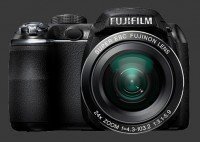
Fujifilm Finepix S3200, 26X
Fujifilm Finepix S3300, 28X
Fujifilm Finepix S3400 and 30X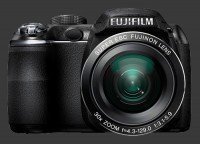
Fujifilm Finepix S4000. All these can focus as close as 2cm from the lens. One may notice that Fuji has not made all these models available in all regions.
This express digital camera review analyses the features, ergonomics, usability, performance and image quality of the Fuji Finepix S2950.
Fuji Finepix S2950 Features
Sensor & Exposure
- 14 Megapixels CCD sensor
- ISO 64 to 1600 sensitivity, at full-resolution
- ISO 3200 and 6400 at 3 megapixels
- 1/2000-8s Shutter-speeds
- PASM Exposure modes
- Program-Shift in P mode
- Exposure-Compensation, ±2 in 1/3 EV increments
- Flash-Compensation, ±2/3 in 1/3 EV increments
- Multi-Segment, Average, Spot & Face-Detect metering
- Exposure Bracketing, 3 frames, maximum ±1 EV
- Auto, Forced, Off or Slow-Sync flash modes
- Optional Redeye reduction
Lens
- 18X Optical zoom range
- Wide-Angle 28-504mm equivalent
- Built-In Stabilization, Shooting-Only or Continuous
- F/3.1-5.6 Fixed aperture varies with zoom
- 2-stop ND-filter aperture simulation
- 40cm-2.5m Normal minimal focus distance
- 5cm Normal Macro mode
- 2cm Super-Macro mode
Image Parameters
- Automatic, 6 presetsSunny (Fine), Shade, Fluorescent 1, Fluorescent 2, Fluorescent 3, Incandescent and custom white-balance
- Standard, Chrome, B&W color modes
- 3 Sharpness levels
Focus
- Single-Shot Center-Focus
- Single-Shot Automatic Focus Selection
- Single-Shot Manual Focus Selection
- Continuous Autofocus
- Tracking Autofocus
- Face-Detect Autofocus
- AF Assist-Lamp
Video
- 1280x720, 640x480 or 320x240 @ 30 FPS Video resolutions
- Mono Sound, Built-in microphone
- Single-Shot or Continuous Autofocus
Drive
- Single-shot
- 1.2 FPS Continuous Top-3 @ 14 MP
- 3 FPS Continuous Top-10 @ 7 MP
- 8 FPS Continuous Top-20 @ 3 MP
- 1.2 FPS Continuous Final-3
- 1.2 FPS Long Period Continuous
- Self-Timer, 2s or 10s
Display & Viewfinder
- 3" LCD, 230K Pixels
- 0.2" EVF, 200K Pixels
- Live histogram during EC
- Grid or HD Guidelines
- Adjustable LCD brightness, 11 steps
- 30 or 60 FPS Refresh rate
Connectivity
- HDMI (1080i) output
- A/V (NTSC / PAL) output
- USB 2.0 connectivity
Misc
- SDHC memory
- Powered by 4 AA batteries
- Automatic Panorama Stitching
- Panorama Assist Mode
- 18 Scene Modes
- Blink Detection
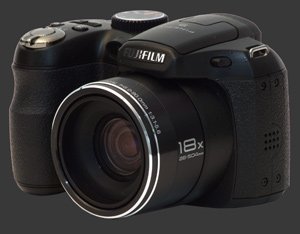
Fujifilm Finepix S2950 Usability - How easy is it to use?
The Fuji Finepix S2950 has a classic ultra-zoom style which looks like a miniaturized DSLR. This makes it noticeably bigger than a travel zoom but lets it have a zoom reach that is rarely achieved by such cameras. Unfortunately for the S2950, contrarily to its near-identical siblings, an 18X optical zoom is now possible in a compact body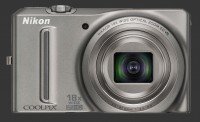
Nikon Coolpix S9100.
Ergonomics
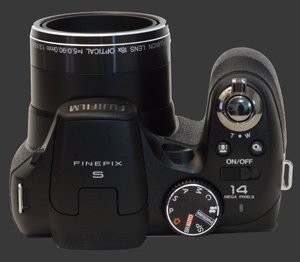
This digital camera has a deep sculpted hand-grip which makes it comfortable to hold securely. The is extremely important for an ultra-zoom since its improves stability which is needed towards the long end of the zoom. The solid lens barrel adds another point of support to use the S2950 with both hands. The entire camera feels very solid, more so the average ultra-zoom. It has a good weight for its size but is light enough to carry around for prolonged periods.
The hand-grip houses a number of controls including a standard two-stage shutter-release. Around it is a rotating zoom controller which moves the lens electronically in 19 coarse steps, making precise framing not always possible. Just behind are the easily accessible Face-Detect and Drive-Mode buttons occupying prime real-estate. One of these buttons should have been EC and the other probably ISO. The Face-Detect button is just a toggle, while the Drive-Mode button cycles through 7 drive modes which surprisingly does not include any self-timers. Just behind is the sliding power-switch which has no chance of accidental activation.
The top of the Finepix S2950 has a true mode-dial with 10 positions. The mode dial is easy to move using your thumb while holding the camera securely. It has good detents which means it will not move accidentally either. The rear of this camera offers 5 buttons plus a 4-way controller with central OK button. All these buttons have a good size and provide positive feedback. The placement of some of these buttons is not entirely optimal. As a minimum, the EC and Face-Detect button should be swapped.
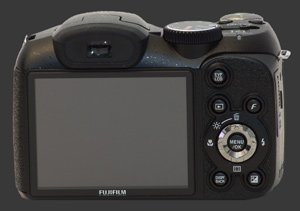
The top button manually toggles between the rear LCD and EVF. Just below it is the Playback button which enters shooting-priority playback mode. This means that the camera immediately returns to Capture mode with a touch of the shutter-release. To the right is Fuji's classic Finepix menu button, marked with an F. This one brings up a quick menu of 3 items: ISO, Image Size and Finepix Color. Normally such menu is used to access frequently modified settings, so we expected WB, FC and Metering there.
The 4-way controller below is used to navigate the menu system. Outside of the menu, which is invoked by the central OK/Menu button, each direction is assigned a function:
- Up: Brightens the display temporarily for increased visibility in bright light.
- Right: Cycles through flash modes when the flash is raised. Options are Auto, Forced, Slow-Sync. An option in the Setup menu controls whether redeye reduction is used or not along with all these options. There is no Off option because that is automatic when the flash is closed.
- Down: Activates Instant Zoom, which is a form of digital zoom, so just leave that button alone.
- Left: Cycles through Normal, Macro and Super-Macro focus modes. The Super-Macro mode automatically zooms out completely which allows the S2950 to focus down to 2cm from the lens.
There are a number of important controls which unfortunately require a trip to the menu system: Self-Timers (2s or 10s), White-Balance, Metering, Bracketing Steps and Flash Compensation. Clearly, having self-timers there is the most inconvenient, particularly since they reset after each use. Another oddity is that the self-timer does not bracket shots unless the shutter is held the whole time while the timer is counting down and the camera takes the bracketed shots.
Functionality
The Fuji Finepix S2950 features full manual-controls with Program, Aperture-Priority, Shutter-Priority and Manual exposure modes. The mode-dial selects one of these exposure modes, plus others that are discussed further down in this review.
While the S2950 has a shutter-speed range of 1/2000s-8s, it actually lacks a true aperture. Instead, this ultra-zoom simulates stopping-down aperture using a 2-stop ND filter. This has several important consequences. The first one is that depth-of-field is fixed by the zoom position and focus distance. Therefore changing the simulated aperture has no effect on depth-of-field. The second is that the camera requires control over ISO to achieve a proper exposure when shutter-speed is fixed.
Normally ISO is manually controllable from 64 to 1600 at full-resolution and up to 6400 at 3 megapixels. This is true in Program, Aperture-Priority and Manual exposure modes. There are also two Auto ISO modes, one that sets the ISO up to 400, the other up to 800. These modes are available in Program and Shutter-Priority modes. Particularly, these are the only two ISO options for Shutter-Priority. In most other modes, ISO is always fully automatic.
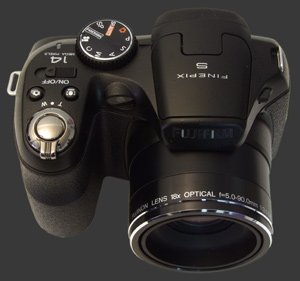
Like most ultra-zooms, there are no control-dials at all on the S2950. To modify exposure parameters, one must press the EC button which is inconveniently located at the extreme lower right cover the the camera. Then, the 4-way controller is used to dial EC using the left or right buttons and the exposure parameter using the up and down buttons. Obviously, in Manual mode EC does not apply, the vertical buttons change shutter-speed while the horizontal ones toggle between the two simulated apertures.
The fully automatic mode, marked by a red camera on the mode-dial, is similar to Program mode except that ISO is locked on Auto and neither EC, FC, White-Balance nor Metering can be changed. The SR Auto mode stands for Automatic Scene-Recognition, it locks pretty much all camera settings except image size and color mode. In this mode, the camera constantly analyzes the scene to determine the type of photo. If it detects a face, it always choose portrait mode. It has no trouble recognizing multiple camera-facing people and does well with profiles. It rarely recognizes tilted faces though.
The SP position on the mode-dial lets the user choose between 17 scene modes. One notable mode is a Fuji classic, the Natural Light & Flash mode, which takes two shots in succession, one with the flash, the other without. Also noteworthy is that Fuji distinguishes Handheld Night and Tripod Night modes. The former uses a high ISO to reduce camera shake, the former uses a slow shutter-speed to get higher image quality.
The Panorama stitches three shots taken from left-to-right or right-to-left in landscape orientation directly in camera. There are two ways for the S2950 to do this. One is called Automatic which lets the camera take the second and third shots as soon as the camera has been sufficiently panned. The other, called Manual, shows an overlay of the previously taken image to help align things but the user must press the shutter each time. In both cases, this camera stores a low resolution panorama.
There is a Custom mode that can store any other exposure mode and settings for convenience. Finally, there is a dedicated Movie mode which lets the camera be ready to record videos and show the correct framing.
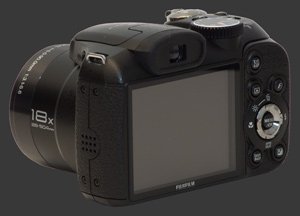
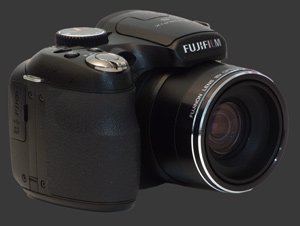
Display & Viewfinder
This ultra-zoom includes a large 3" LCD with 230K pixels. Normal visibility is average and susceptible to bright light. Activating the display brightening feature improves things considerably. Motion is fluid with a reasonable refresh rate. The number of pixels is on the low side by modern standards but sufficient for recognizing an out-of-focus image.
There is a miniscule 0.2" EVF with 200K pixels. In itself, it is a little dim but given that it gets shielded from ambient light, this is not much of a problem. Motion is just as fluid as the LCD and precision is comparable. Colors are a little off with a slight orange tint to them, so adjusting white-balance based on the EVF is not so reliable.
Both displays react to changes in Exposure-Compensation but the S2950 makes no attempt to keep the preview accurate while in manual or semi-automatic modes.
Misc
There is plastic tripod mount at the bottom of this camera. It is inline with the camera's physical center but not with the lens. This is good for balance but not for panoramic photography.
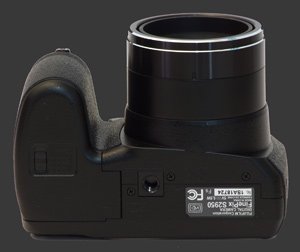
The camera is advantageously powered by 4 AA batteries which make it quite versatile. The batteries and memory cards share the same compartment which opens at the bottom of the camera. Since AA batteries simply slide into place, they can also slide out, so care must be taken when changing memory cards.
Fujifilm Finepix S2950 Performance - How well does it take pictures?
The Fuji Finepix S2950 is a capable value ultra-zoom defined by its lens and form-factor. There are a number of similar HD-capable ultra-zooms with stabilized wide-angle lenses that run on AA batteries and offer an EVF but most find themselves in a higher-end category with more controls and, most importantly, a significantly higher price tag.
Image Quality
Its high-resolution sensor with 14 megapixels is probably its weakest point as it causes visible noise at all ISO sensitivities. Still, both ISO 64 and 100 are completely usable even for large prints. ISO 200 sees a drop in image quality with added softness and lower contrast. ISO 400 is similar but both are usable for medium prints. ISO 800, depending on the scene, can make a passable mid-size print as well. ISO 1600 is best reserved for the smallest prints or web-use.
In the case of this ultra-zoom, ISO 64 and 100 are capable of keeping an acceptable level of details, providing the lens lets it through. Generally speaking, the 18X optical zoom lens is rather good. There is a hefty amount of edge softness at wide-angle which is unfortunate since one cannot compensate for this. However, zooming in to about 2X reduces considerably reduces edge softness. Towards the end of the zoom, things get a little soft once more but not overly so.
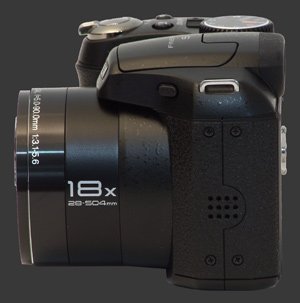
Optical distortion shows strong barrel distortion at wide-angle. Zooming in between 2X and 4X makes it disappear. Further in though, barrel distortion gets replaced by a slight amount of pincushion distortion. There is some discernible vignetting near wide-angle. Towards the middle of the zoom, things get better but it reappears towards the telephoto end of the zoom where it becomes quite disturbing.
Color accuracy is quite good. In Standard mode both colors and contrast appear natural. In Chrome mode, colors become slightly more saturated but contrast greatly increases. This gives more punch to results for scenes of low contrast while keeping colors sufficiently close to reality. For most scenes though, this leads to clipped shadows. Automatic white-balance is generally quite good, only leaving the occasional warm cast under artificial light. Finally, custom white-balance works well.
Multi-Segment Metering is perhaps the S2950's strongest point. It is very reliable and not much EC is required under typical conditions. Resulting exposures are bright without blowing out anything more than small highlights. There are also Average and Spot metering modes which work just as expected.
Speed & Performance
Speed of the S2950 is on the slow side of average. It takes about 2½s to power on and 1s to power off. The lens moves from wide-angle to the telephoto-end in just under 3 seconds. It takes about one second to get in or out of playback mode. Most buttons have a slight lag before responding which makes the camera often feel sluggish.
Given the huge zoom range, it is unsurprising that focusing speed be extremely variable. In good light, this camera can focus in about ½s which is good for this class of camera. As light levels get lower or the lens is zoomed-in, focusing speed slows down and may exceed 2s at times. Average focusing speed is about 1s, which is a little slower than average. There is a barely perceptible shutter-lag but shot-to-shot speeds are glacial at over 3 seconds.
The battery-life of the Fuji Finepix S2950 is exceptional. It can take up to 700 shots per charge according to the CIPA standard with a single set of 4 AA batteries. This, plus the general availability of such batteries, makes it particularly suitable for long trips away from power sources. In a bind, disposable AAs are available everywhere and cost much less compared to proprietary batteries.
Fujifilm Finepix S2950 Conclusion
The Fuji Finepix S2950 is a great value for its feature set. That it packs a stabilized wide-angle 18X optical zoom lens with full manual-controls, spot-metering, shutter-speeds from 1/2000s to 8s, an EVF and HD video for less than $200 USD is truly exceptional. It even runs on readily available AA batteries and uses SDHC memory, the least expensive type of flash storage, keeping its total cost of ownership low.
While the performance of the S2950 is acceptable for general photography involving relatively still subjects in good light, it certainly does not compare with cameras having a similar feature set. Since most of them cost roughly twice as much, that is easily understandable. Fuji makes high-end ultra-zooms riddled with features such as the recently reviewed HS20 EXR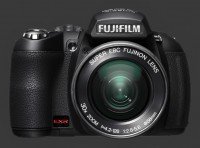
Fujifilm Finepix HS20 EXR which would be a great choice if budget permits.
One advantage other than price of the Fuji Finepix S2950 is its simplicity and ergonomics. This digital camera handles well and its controls are simple and, for the most part, fairly direct. Also, the miniature DSLR-style and EVF give it excellent stability when shooting towards the long end of the zoom. In the end, the S2950 provides a unique price-point for all the features it has to offer.
 |
Please Support Neocamera
All information on Neocamera is provided free of charge yet running this website is a huge endeavor. Purchases made via affiliate links found throughout the site help keep it running and up-to-date. There is no additional cost to you, so please consider buying via these links to our affilates:
If you found any information on this site valuable and did not purchase via our affiliate links, please considering donating via PayPal:
Any amount will be greatly appreaciated. Thank you for your support!
Fujifilm S2950 Highlights
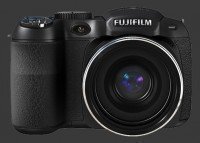
Sensor-Size: 6 x 5mm

Actual size when viewed at 100 DPI
| 14 Megapixels Ultra Zoom | ISO 64-1600 |
| 18X Wide Optical Zoom | Shutter 1/2000-8s |
| Built-in Stabilization | Full manual controls |
| 0.20" Built-in EVF 200K Pixels | Custom white-balance |
| 1.2 FPS Drive, 3 Images | Spot-Metering |
| 1280x720 @ 30 FPS Video Recording | Standard AA Battery |
| 3" LCD 230K Pixels | Secure Digital High Capacity |
Updates
2025.01.18

Fujifilm GFX 2025 Lens Roundup
Lens Review roundup of Fujifilm GFX Medium-Format lenses. Quality, performance and handling of the GF20-35mm F/4R WR, GF30mm F/3.5 Tilt-Shift and the GF55mm F/1.7.
2024.11.18

Best 2024 Photography Gifts for Every Budget
Great gifts for photographers and photo enthusiasts selected for every budget among the best products of 2024.
2024.08.07

Eye Protection Tips for Professional Photographers
The four main considerations for professional photographers regarding eyewear.
2024.07.14

Fujifilm X100VI Review
Flagship fixed-lens compact digital camera with a 40 MP sensor and Image-Stabilization, a first for the series. Retro design featuring dual control-dials, plus direct ISO, Shutter-Speed and EC dials. Its hybrid viewfinder can switch between EVF and OVF mode.
2024.05.09

Fujifilm GFX100 II Review
Flagship 102 Megapixels Medium-Format Mirrorless Digital Camera with 8-Stop 5-Axis IBIS, 8 FPS Drive, 8K Video and 400 MP Super-Resolution capture in a weatherproof and freezeproof body with dual control-dials and dual memory-card slots.
2024.04.03

Fujifilm X-T5 Review
Newest Fujifilm flagship boasting a 40 MP APS-C sensor, 5-axis IBIS with 7-stop efficiency, 15 FPS continuous drive, 6.2K Video capture, dual control-dials and dual SDXC UHS-II slots in a sturdy weatherproof and freezeproof body.
2023.11.20

Best Digital Cameras of 2023
Find out which are the Best Digital Cameras of 2023. All the new Mirrorless Digital Cameras from entry-level to high-end professional.
2023.07.10

Fujifilm X-H2 Review
40 Megapixels APS-C Hybrid Mirrorless Digital Camera with 7-stop IBIS. Fastest shutter ever and 8K video capture. Large builtin EVF with 0.8X magnification and 5.8 MP, plus an Eye-Start Sensor. Packed with features and large number of controls in a weatherproof and freezeproof body.
2023.05.07

Sony FE 20-70mm F/4G Review
Review of the unique Sony FE 20-70mm F/4G lens. The optical zoom of this lens spans ultra-wide-angle and medium focal-length coverage, making it one of the most versatile Full-Frame lenses on the market.
2023.01.15

Huion Inspiroy Dial 2 Review
Review of the Huion Inspiroy Dial 2 tablet, a medium sized drawing surface with dual dials and customizable buttons. Connects via USB-C or Bluetooth 5.0 with Windows, Linux and Android support.
2022.12.08

How to Pack for a Photo Trip
Find out how to pack for a travel photography trip, carry your gear safely while meeting airline regulations.
2022.11.13

Best Digital Cameras of 2022
The best digital cameras of 2022. A short list of the most outstanding models in their respective categories. Choose one for yourself or as a gift.














